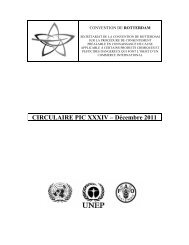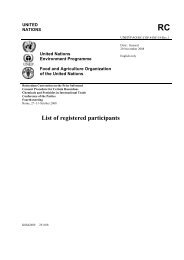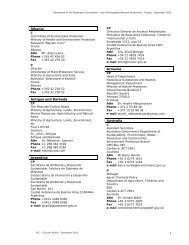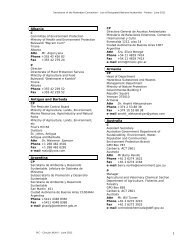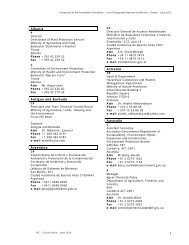RC - What is RC? - Rotterdam Convention
RC - What is RC? - Rotterdam Convention
RC - What is RC? - Rotterdam Convention
You also want an ePaper? Increase the reach of your titles
YUMPU automatically turns print PDFs into web optimized ePapers that Google loves.
a<br />
in<br />
studies, the compound induced unscheduled DNA synthes<strong>is</strong> in Syrian<br />
hamster embryo fibroblast cultures but not in rat hepatocyte<br />
cultures. It induced unscheduled DNA synthes<strong>is</strong> in rats in vivo,<br />
but did not induce sex-linked recessive lethal mutations in<br />
Drosophila melanogaster.<br />
In the only long-term (2 years) study, in which rats received<br />
diet containing hexachlorobutadiene at doses of 0.2, 2 or 20 mg/kg<br />
body weight per day, an increased incidence of renal tubular<br />
neoplasms was observed only at the highest dose level.<br />
1.7.4 Mechan<strong>is</strong>ms of toxicity<br />
The nephrotoxicity, mutagenicity and carcinogenicity of<br />
hexachlorobutadiene <strong>is</strong> dependent on the biosynthes<strong>is</strong> of the toxic<br />
sulfur conjugate 1-(glutathion- S-yl)-1,2,3,4,4-pentachloro-<br />
1,3-butadiene (GPB). Th<strong>is</strong> conjugate <strong>is</strong> mainly synthes<strong>is</strong>ed in the<br />
liver and <strong>is</strong> further metabolized in the bile, gut and kidneys to<br />
1-(cystein- S-yl)-1,2,3,4,4-pentachloro-1,3-butadiene (CPB). The<br />
activation of CPB, dependent on cysteine conjugate ß-lyase, to a<br />
reactive thioketene in the proximal tubular cells finally results<br />
covalent binding to cellular macromolecules.<br />
1.8 Effects on humans<br />
No pathogenic effects in the general population have been<br />
described.<br />
There have been two reports of d<strong>is</strong>orders among agricultural<br />
workers using hexachlorobutadiene as a fumigant, but they were also<br />
exposed to other substances. An increased frequency of chromosomal<br />
aberrations was found in the lymphocytes of peripheral blood of<br />
workers engaged in the production of hexachlorobutadiene and<br />
reported to be exposed to concentrations of 1.6-12.2 mg/m 3 .<br />
1.9 Evaluation of human health r<strong>is</strong>ks and effects on the<br />
environment<br />
1.9.1 Evaluation of human health r<strong>is</strong>ks<br />
As there have been very few human studies, the evaluation <strong>is</strong><br />
mainly based on studies in experimental animals. However, limited<br />
human in vitro data suggest that the metabol<strong>is</strong>m of<br />
hexachlorobutadiene in humans <strong>is</strong> similar to that observed in<br />
animals.<br />
Hexachlorobutadiene vapour <strong>is</strong> considered to be irritating to<br />
the mucous membranes of humans, and the liquid <strong>is</strong> corrosive. The<br />
compound should also be regarded a sensitizing agent.<br />
The main target organs for toxicity are the kidney and, to a<br />
much lesser extent, the liver. On the bas<strong>is</strong> of short- and long-term<br />
oral studies in rats and mice, the NOAEL <strong>is</strong> 0.2 mg/kg body weight<br />
per day. In one short-term inhalation study in rats (12 days,



